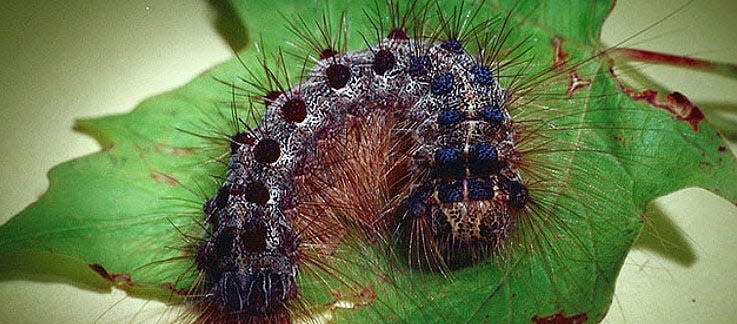Never mind the cicadas, spongy moths will be a problem in Pa. Here’s where
While nature lovers are fascinated by the upcoming, once-in-a-generation emergence of cicada broods, attention is also turning to a far more dangerous bug — the spongy moth.
The destabilizing and ecologically-harmful spongy moth feeds on hundreds of types of shrubs, fruit and nut trees in Pennsylvania, and efforts are underway to eradicate the spongy moth in Pennsylvania state parks.
According to the Pennsylvania Department of Conservation and Natural Resources, female spongy moths lay up to 1,000 eggs in masses on trees and stones in June and July.
Eggs will then hatch from mid-April to early May the following spring.
Pennsylvania now spraying state parks to head off spongy moth infestations
The conservation and natural resources department is now spraying 18 state parks, along with the Grey Towers National Historic Site in Pike Valley, to kill any spongy moth eggs that are ready to hatch.
The following state parks are on the list for this round of spongy moth spray treatment:
Bald Eagle, Centre County
Big Spring, Perry County
Colonel Denning, Cumberland County
Colton Point, Tioga County
Hyner View, Clinton County
Kings Gap, Cumberland
Leonard Harrison, Tioga County
Little Pine, Lycoming County
Ole Bull, Potter County
Penn Roosevelt, Centre County
Poe Paddy, Centre County
Poe Valley, Centre County
Prince Gallitzin, Cambria County
R.B. Winter, Union County
Ravensburg, Clinton County
Reeds Gap, Mifflin County
Sand Bridge, Union County
Whipple Dam, Huntingdon County
"These destructive, invasive insects go through cycles where outbreaks generally occur every five to ten years,” said Forest Health Manager Rosa Yoo in a statement released by the conservation and natural resources department. "We are entering in our fourth year of the outbreak cycle, and egg mass surveys from last year determined the need for suppression efforts again this year.
"The good news is that we observed a decline in spongy moth defoliation from 850,000 acres in 2022 to 440,000 acres in 2023, signifying a decline in spongy moth populations and the importance of these suppression activities to help continue to reduce spongy moth populations.”
What does the spongy moth and its eggs look like?
Spongy moth egg masses are flat and mud-like, according to the USDA. Spongy moth egg masses are hairy, spongy, and cream or brown-colored.
Harmful Spongy moth, spotted latnerfy: If you see this, destroy it: USDA says to 'smash and scrape' these large invasive egg masses
"Often confused with other caterpillars," read the department of conservation and natural resources' description, "the spongy moth caterpillar has a yellow and black head, a hairy body with five pairs of blue spots, followed by six pairs of red spots."

How do I get rid of spongy moth infestations on my property?
There are several ways to rid your property of spongy moths.
Planet Natural Resource Center suggests using moth traps, pest barriers and garden insect sprays.
Your spongy moth primer: Spongy moth: Next invasive species destroying trees and shrubs, and how to kill them
The conservation and natural resources department also has a set of instructions for manually removing spongy moth eggs.
"Methods include removal of egg masses before they hatch and removal of unnecessary yard objects where egg masses can be hidden, such as piles of old wood, building materials, dead branches, firewood, and other refuse," read a portion of the department's spongy moth removal advice. "Egg masses should be scraped into a sealed container or bag and disposed.
"Another control tactic is wrapping burlap around the trunks of trees where spongy moth larvae can hide during the day. The larvae hiding under the burlap are then scraped into a can of soapy water, killing them."
Damon C. Williams covers trending and regional developments for PhillyBurbs.com. Support our journalism with a subscription.
This article originally appeared on Bucks County Courier Times: Move over, cicadas; the spongy moth is the much more dangerous bug

